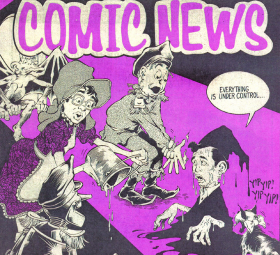In Other Comic News
Skip to commentsMark Parisi and Kim Tomsic, Rockwell Kent, Sarah Anderson, Barbara Shermund, Dick Brooks, Stevan Dohanas, and Jef Mallett and the class of 2002.


above: The Jackson Twins cartoonist and Saturday Evening Post cover model Dick Brooks
The daughter of a cartoonist, Virginia Brooks describes her childhood in Westport, Connecticut, as “hilarious.”
The Carefree artist spent the 1950s and 1960s attending school with the cartoonists behind the likes of Popeye.
“It was an unusual upbringing,” Brooks said.
The Foothills Focus talks to Dick Brooks’ daughter about “My Life as a Cartoonist’s Daughter!”

**********

In Hugh Merrill’s 1995 book, Esky: The Early Years at Esquire, which covers the decades during which Shermund was a regular contributor to the men’s magazine, she is mentioned only once, as “Beverly Shermund.” In Fred E. Basten’s 1996 book The Lost Artwork of Hollywood, a poster illustration created by Shermund for the 1943 film “Du Barry Was a Lady” is credited to “Helen Shermund.” And in Dale Kramer’s Ross and the New Yorker, from 1951 and among the first books to document the history of the magazine, Shermund isn’t mentioned by name but rather as “a pretty girl not long in from California.” This despite Shermund having made north of 1,200 appearances in the magazine through the 1920s and ’30s, including 600-odd cartoons, nine color covers and countless other assorted illustrations.
Andy Downing for Matter talks to Caitlin McGurk about her new biography of cartoonist Barbara Shermund.
This initial twinge of interest launched McGurk on a 12-year odyssey that first resulted in a 2019 retrospective of Shermund’s work at the Billy Ireland and more recently culminated in a new biography of Shermund penned by McGurk, Tell Me a Story Where the Bad Girl Wins: The Life and Art of Barbara Shermund (Fantagraphics), which the author will celebrate with a release party at Seventh Son Brewing on Thursday, Nov. 14.


**********

New comic strip offerings in 2001 did not make much of an impact. The top new strip, Jef Mallett’s Frazz, only premiered in 9 papers, a pretty anemic number to take top honors. The rest of the new strips could not even manage the 5 paper mark this year. Here is the breakdown: Frazz –…
Our biggest gainer for 2002 took 2nd place honors for a rookie strip of 1999. Get Fuzzy gained 11 papers, the most for 2002. Other big gainers this year were Non Sequitur with 6 papers and Zits continued its dominating success with 5 more papers. Here is the breakdown of all the papers that gain…
Jeffrey Lindenblatt’s Paper Trends, his examination of newspaper comics circulation, looks at the year 2002.

**********

Eisner-nominated cartoonist Sarah Andersen’s strip Sarah’s Scribbles, which mixes observations from her life with jokes about monsters, cats, and weird animals, has been running online for more than 10 years on platforms including Tumblr, Instagram, and GoComics. The fifth and latest Sarah’s Scribbles print collection is titled Adulthood Is a Gift (Andrews McMeel, out now).
How early did you get started making webcomics?
When I was about 19 I started casually uploading them, and they did well. I had started experimenting with comics while I was at art school, but I didn’t know it could be my career.
Shaenon K. Garrity for Publishers Weekly interviews Sarah Anderson about her comic strip and new book.

**********

Rockwell Kent (1882-1971) was not a cartoonist in any typical sense of the genre. He was insanely prolific across all media and seemed oblivious to formal silos that bother art critics and scholars. He worked in book and magazine illustration, painting, greeting cards and postage stamps, bookplates, murals, and, yes, comics (under the playful pseudonym, “William Hogarth, Jr.” for Vanity Fair). He was a working artist who liked to turn a buck, as entrepreneurial as he was genre agnostic. Which is to say that he was an artist in the American grain.
Still, he was best known as a book illustrator, and aside from Dr. Seuss and John Tenniel may be the most famous of all time. But in the simplicity of his style, the thickness of his line, and his instinct for abstraction, all of Kent’s art followed some of the same aesthetic impulses as the comic strip medium that matured with him between the World Wars.
For our Wayback Wednesday installment we link to Steve Smith’s appreciation of illustrator Rockwell Kent.


**********

“It was December 2019 when I got this call. So to go into the pandemic working on this book together was such a gift,” [Kim] Tomsic said. “Lovely distraction, anyway.”
It wasn’t all smooth sailing though, [Mark] Parisi said.
“The original concept was actually a little different,” he recalled. “The idea, which sounded great but it didn’t work in practice, was that the girl … would write an entire diary. And then the boy, Alex, would find the diary, and go in and write corrections on each page. So you would read her version and read what he corrected, but it was kind of unreadable.”
“But the concept of the he said-she said was too good to let go, so we kind of put our heads together and came up with [writing] one page each, or one entry each, alternating throughout the book,” Parisi said.
Kim Tomsic and Mark Parisi discuss their new book with Peter Chianca of Boston.com.
feature image: excerpt from The Saturday Evening Post of January 14, 1956 by Stevan Dohanas via art.com


Comments
Comments are closed.